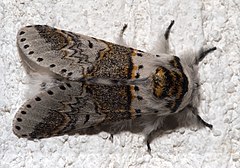Furcula furcula
| Sallow kitten | |
|---|---|

| |
| Male | |
| Scientific classification | |
| Kingdom: | |
| Phylum: | |
| Class: | |
| Order: | |
| Family: | |
| Genus: | |
| Species: | F. furcula
|
| Binomial name | |
| Furcula furcula (Clerck, 1759)
| |
Furcula furcula, the sallow kitten, is a lepidopteran from the family Notodontidae.

The moth can be found in Europe (including the Mediterranean region), Anatolia and the North of Iran. The moth is attracted to light.
The sallow kitten is grey/white and has a wingspan of 27 to 35 mm. The first part of the wing has a large grey middle band. differs from Furcula bifida in its generally smaller size, but more especially in the shape of the black line forming the outer margin of the central band; this is always more or less angled or dentate towards the front margin of the wings, whereas, in the poplar kitten, this portion of the line forms a clean curve.
The flight period ranges from April to the end of August. The moth has two generations per year.
The caterpillar can grow up to 35 mm and is bright green with a purple brown marking on the saddle. The caterpillar can be found from June up to September. The host plants are the willow, birch and poplar.[1] The prolegs consist of long and thin extremities.
References
Further reading
- South R. (1907) The Moths of the British Isles, (First Series), Frederick Warne & Co. Ltd., London & NY: 359 pp. online
